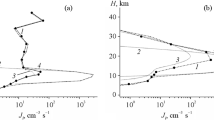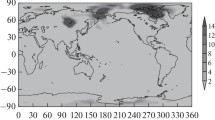Abstract
Results of observation of the generation of aerosol particles and droplets in mixtures of saturated water vapor with air and molecular gases are described. The kinetics of generation of aerosol and droplets was studied in the absence of a monokinetic electron beam and under its influence on a gas mixed with supersaturated water vapor formed in the process of a controllable pressure discharge from a spherical chamber of 1.4 m diameter with the gas mixture into a vacuum reservoir ~40 m3 in volume. The generation kinetics was recorded by the low-angle laser beam scattering method (for droplets) and with an aerosol spectrometer (for particles). Experimental results show a significant dependence of droplet and particle generation on the ionizing radiation effect. The 3D computer simulation of the process of super-saturated water vapor condensation on ions by the lattice Boltzmann method (LBM) and molecular dynamics (MD) describes qualitatively the experimental results.
Similar content being viewed by others
References
E. P. Ney, “Cosmic radiation and the weather,” Nature (Gr. Brit.) 183, 451–452 (1959).
N. Marsh and H. Svensmark, “Cosmic rays, clouds and climate,” Space Sci. Rev. 94 (1–2), 215–230 (2000).
M. Andreas, B. Enghoff, and H. Svensmark, “The role of atmospheric ions in aerosol nucleation: A review,” Atmos. Chem. Phys. 8 (16), 4911–4923 (2008).
G. F. Krymskii, “Cosmic rays and the weather,” Nauka Tekh. Yakutii, No. 1 (8), 3–6 (2005).
D. J. Wilson, Wilson Chamber (Izd. Inostr. Liter., Moscow, 1954) [in Russian].
A. E. Nielsen, Kinetics of Precipitation (Pergamon, Oxford, 1964).
G. F. Krymskii, V. V. Kolosov, A. P. Rostov, and I. S. Tyryshkin, “Experimental setup for investigating the water vapor nucleation in an artificial atmosphere,” Opt. Atmos. Okeana 23 (9), 820–825 (2010).
G. F. Krymskii, V. V. Kolosov, and I. S. Tyryshkin, “Vapor condensation under the ionizing effect,” Opt. Atmos. Okeana 23 (9), 826–829 (2010).
Yu. N. Ponomarev, A. V. Klimkin, A. S. Kozlov, V. V. Kolosov, G. F. Krymskii, A. N. Kuryak, S. B. Malyshkin, and A. K. Petrov, “Study of condensation of supersaturate water vapor under ionization of the atmosphere and accompanying characteristic IR radiation,” Solnechno-Zemnaya Fiz., No. 21, 58–61 (2012).
V. F. Tarasenko, S. I. Yakovlenko, V. M. Orlovskii, A. N. Tkachev, and S. A. Shunailov, “Production of powerful electron beams in dense gases,” J. Experim. Theor. Phys. Lett. 77 (11), 611–615 (2003).
N. N. Das Gupta and S. K. Ghosh, “Wilson chamber and its application to physics,” Rev. Mod. Phys. 18 (2), 225–365 (1946).
A. G. Amelin, Theoretical Foundations of Fogging during Vapor Condensation (Khimiya, Moscow, 1972) [in Russian].
J. Kolafa, “Time-reversible always stable predictor-corrector method for molecular dynamics of polarizable molecules,” J. Comput. Chem. 25 (3), 335–342 (2003).
S. Chen and G. D. Doolen, “Lattice Boltzmann method for fluid flow,” Annu. Rev. Fluid Mech. 30, 329–364 (1998).
X. Shan and H. Chen, “Lattice Boltzmann model for simulating flows with multiple phases and components,” Phys. Rev., E 47 (3), 1815–1819 (1993).
A. L. Kupershtokh, D. A. Medvedev, and D. I. Karpov, “On equations of state in a lattice Boltzmann method,” Comput. Math. Appl. 58 (5), 965–974 (2009).
A. L. Kupershtokh, D. A. Medvedev, and I. I. Gribanov, “Modeling of thermal flows in a medium with phase transitions using the lattice Boltzmann method,” Vychislitel’nye Metody Programmirovanie 15 (2), 317–328 (2014).
Author information
Authors and Affiliations
Corresponding author
Additional information
Original Russian Text © A.V. Klimkin, A.N. Kuryak, Yu.N. Ponomarev, A.S. Kozlov, S.B. Malyshkin, A.K. Petrov, A.L. Kupershtokh, D.I. Karpov, D.A. Medvedev, 2015, published in Optika Atmosfery i Okeana.
Rights and permissions
About this article
Cite this article
Klimkin, A.V., Kuryak, A.N., Ponomarev, Y.N. et al. Generation of aerosol and droplets in binary mixtures of saturated water vapor with air and molecular gases. Atmos Ocean Opt 29, 127–134 (2016). https://doi.org/10.1134/S102485601602007X
Received:
Published:
Issue Date:
DOI: https://doi.org/10.1134/S102485601602007X




